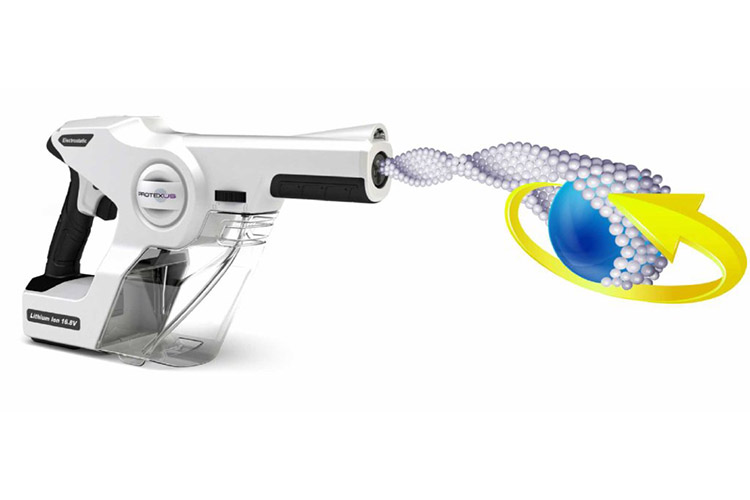Electrostatic disinfection is a treatment method that quickly and evenly coats a surface with a disinfecting solution. The electrostatic process atomizes the cleaning solution with highly pressurized air. The droplets pass through an electrode inside the equipment nozzle creating a magnetically charged spray as it exits. The positively charged solution particles cling to and completely cover all contact points including curved and hard to reach surfaces.
Because positively charged molecules repel each other, once a surface has been coated, additional disinfectant particles are diverted to other surfaces. Therefore, it is as practical a treatment as it is effective. Once a surface has been coated, the positively charged spray will no longer be attracted, any additional particles are attracted to other surfaces not yet covered. From floors and objects with complex shapes, to and walls and hard to reach places, we are able to thoroughly blanket surfaces with electrostatic disinfection.
Electrostatic Disinfection Benefits
Beyond infection control, there are countless practical uses and benefits with the latest electrostatic disinfection technology.
1. Saves time. Wiping surfaces with a microfiber towel is time-consuming. This technology is so much faster that it can reduce labor time and costs by 50% compared to traditional cleaning methods.
2. Saves money. The uniform application of disinfectant eliminates unnecessary overuse and waste.
3. Improves results. A touchless process prevents the possibility of cross-contamination.
Reducing the Spread of Infection
Depending on the concentration and dilution of the disinfecting solution used with the electrostatic sprayer, we can kill the following infectious contaminants.
BACTERIA: Staphylococcus aureus, Staphylococcus aureus – methicillin resistant (MRSA) & glycopeptide-resistant (GRSA), Staphylococcus epidermidis, Salmonella enterica, Pseudomonas aeruginosa, Streptococcus pneumoniae, Escherichia coli O157:H7, Acinetobacter baumannii, Vancomycin resistant Enterococcus faecalis, Carbapenem resistant Klebsiella pneumoniae, Clostridium spores, Klebsiella pneumoniae
VIRAL: Covid-19, Respiratory syncytial virus, Rhinovirus Type 14, Influenza Virus H1N1, Human Immunodeficiency Virus Type 1 (HIV-1), Hepatitis A virus, Hepatitis B virus, Hepatitis C virus, Avian influenza A (H5N1), Norovirus, Poliovirus Type 1, Coxsackievirus B3, Herpes simplex virus type 1
TB: Mycobacterium bovis (TB)
FUNGAL: Aspergillus fumigatus, Trichophyton interdigitale
BIOFILM: Pseudomonas aeruginosa (in a biofilm), Staphylococcus aureus (in a biofilm)
Additional Facts
The disinfectants we use are safe for people, animals and plants. Electrostatic disinfection can be performed safely around standard office equipment, laptops, monitors and keyboards when not applied directly to sensitive electronics. It is recommended that building occupants put away paper documents and any items they do not want to be sprayed, prior to the scheduled service. Electrostatic disinfection kills unwanted pathogens from targeted surfaces, but it does not protect surfaces from future contamination. For high touch and shared or public areas, it may be beneficial to schedule electrostatic disinfection more frequently in your cleaning program.
Learn about our electrostatic disinfection services here or contact us for more information.






